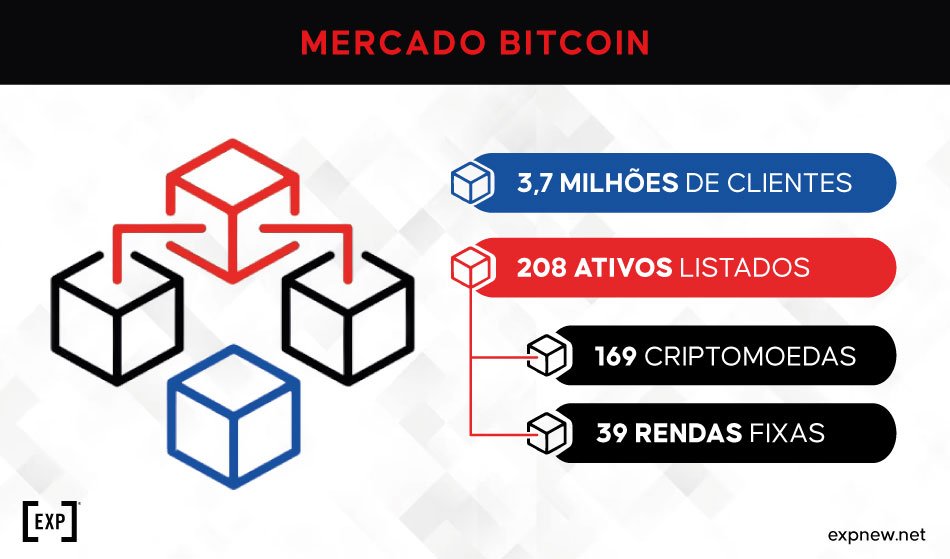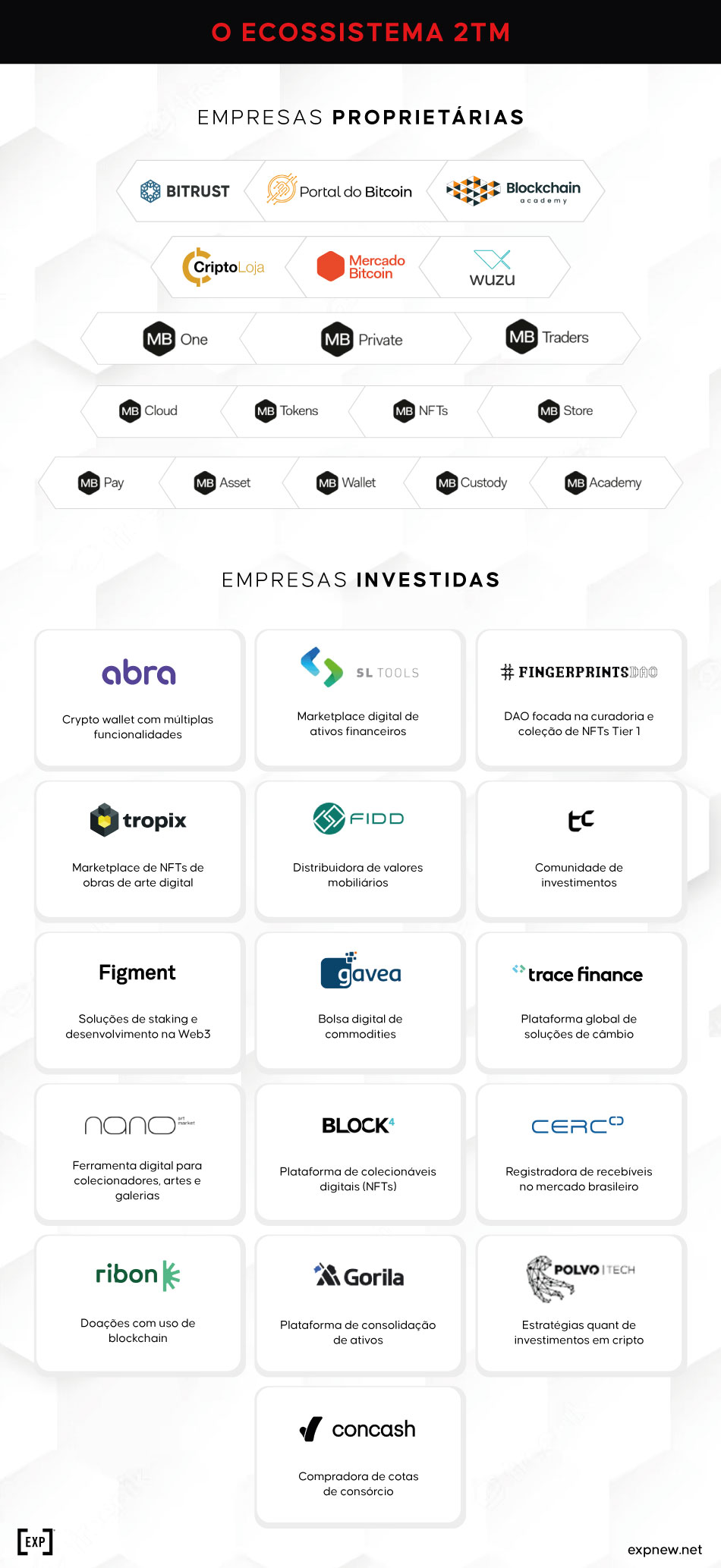
By Equipe de Redação
Posted in February 28, 2023

Roberto Dagnoni, chairman and CEO of 2TM, the holding company that controls Mercado Bitcoin, said in an interview with [EXP] that tokenization facilitates access to assets that previously could only be bought by large investors.
By Denize Bacoccina
After the crisis of 2022, with the drop in asset prices and the collapse of the FTX exchange, 2023 started well for the cryptocurrency market in Brazil, which is already the seventh largest in the world and the largest in Latin America, according to the 2022 report by Chainalysis, a blockchain consulting firm.
The collapse of FTX due to management fraud and misappropriation of investor funds accelerated the approval of Brazilian legislation for the sector in December, with regulations expected to be finalized by mid this year. There is still uncertainty in the government regarding which agency will be responsible for this regulation, whether it will be the Central Bank or the CVM, the agency of the Ministry of Finance that already oversees the capital market.
Roberto Dagnoni, chairman and CEO of 2TM, the holding company that controls Mercado Bitcoin, argues that regulation should be under the jurisdiction of the Central Bank, as he believes it is better equipped to handle the primary use of cryptocurrencies in the Brazilian market, which is investment. “After this decision, the regulator will establish specific rules, and we will understand the level of controls that will be implemented,” he said in this interview with [EXP].
In addition to cryptocurrency brokerage, the company has several tokenization projects, a market that is still in its early stages in Brazil but has the potential to expand to many sectors, essentially any involving the trading of physical or digital assets. Thus, assets that could only be bought by large investors before are now sold in fractions, similar to shares. “It’s not just a game for millionaires. Everyone can participate,” he says.
Roberto also discussed the company’s involvement in the development of the Digital Real, a project by the Central Bank that is expected to enter testing later this month, as well as plans for some of the 20 companies that have been acquired or received investments from 2TM in the past two years.
Roberto, can you explain in simple terms what tokenization is and how it works for companies and investors?
Roberto Dagnoni – To explain it in one sentence: tokenization is a digital representation of any asset. This digital representation allows for the fractionalization of that asset, which can be divided into one hundred units, one thousand units, or even one million units. Once the token is on the trading platform, it can be bought and sold 24 hours a day, seven days a week.
Blockchain is decentralized worldwide. You can buy Bitcoin on Coinbase, transfer it to your account here at MB (Mercado Bitcoin), and sell it here in Brazil. Or transfer it to other exchanges in Brazil. The interoperability between exchanges is already established in the protocol. The token is automatically available on multiple platforms. You don’t have to do an IPO here, an IPO on the NYSE, an IPO on the Nasdaq.
There are 20,000 coins, and here at MB (Mercado Bitcoin), we work with more than 200. The token is launched, and exchanges worldwide start listing it on their platforms.
Although it is still a new market, we have significant adoption in Brazil. Last year, MB closed with 3.7 million customers, similar to the number of equities investors on B3 (Brazilian stock exchange), which has been in operation for much longer. There are already ten million individuals with exposure to cryptocurrencies.
Blockchain has a very collaborative concept, developed with the participation of users. The younger generation understands this concept very well, including receiving rewards during this development.

Compared to the physical market, is there a higher possibility of bubbles in this type of market?
I don’t think so. I think the possibility of a bubble is similar. The difference here is greater transparency. For example, you have your miles from Múltiplos or Smiles, and when you want to buy a blender for 30,000 points, you never know if it’s expensive or cheap. The difference here is that you have a value on the screen, price fluctuations are public, and they follow the law of supply and demand. Things are worth what someone is willing to pay.
And for use in loyalty programs, rewards, and cashback, tokens have an advantage because they can be used with any of the other 200 assets, while loyalty programs are more tied to a specific list.
Is the Brazilian market accepting tokens well? What type of product is being tokenized the most?
Primarily credit assets. We have already tokenized energy contracts, receivables, consortiums, real estate, rental receivables, import operation receivables, and court-ordered payments (precatórios). The first one we did in 2019 was court-ordered payments, which are public debts. Normally, these court-ordered payments have a high value, and you would have to buy the entire amount, for example, 10 million Brazilian reais. Only an institutional investor can afford that. With tokenization, you can invest 1,000 reais in that court-ordered payment. You buy a fraction of an asset. It’s like owning a share of a company.
This reminds me of derivatives, and derivatives remind me of crises, market crashes, and so on. Is there a possibility to multiply these tokens? What is the risk?
In the tokenization we are doing, there is zero leverage. We don’t have it in Brazil yet, but there are already cryptocurrency derivatives, futures options, and ETFs (exchange-traded funds) in the world, and they are regulated.
You recently created the token for Ambify, a subsidiary of Ambipar, which has a calculation for compensating greenhouse gas emissions. How does this asset work? Who performs the calculation?
This is a good example of fractionalization and access. What Ambipar is doing is providing fractional access to an asset that was previously only available in the institutional market in large volumes. Today, if you fly with Gol, for example, at the end of the flight, they ask if you want to offset your carbon footprint. A tool calculates how many tokens you need to buy to offset it and directs your money to a specific carbon offset project. The Ambify token follows the same logic.
We have also created other NFTs where the funds were directed to indigenous projects. Tokenization allows for the structuring of projects in a cheaper way with fewer intermediaries. For example, to create an FDIC (Federal Deposit Insurance Corporation), the project needs to have at least 100 million reais in order to cover the costs. Tokenization can be done with a value of up to 1 million reais because it is a more efficient and cheaper structure.
Is the ESG agenda strong in this market? Are there other initiatives in this direction?
Looking at the volume, not yet, but there is already a significant demand for studies. We conducted a study for the purchase of preservation areas. We need to start with small cases to show that it works, that it is simple, and especially that retail investors can buy and participate. It’s not just a game for millionaires. Everyone can participate.
Which sectors have the most tokenization projects?
In our case, the main categories are court-ordered payments, consortiums, and receivables.
You mentioned at an event with the Experience Club about real estate and fractional deeds. Is this already being done?
We have already done it as an experiment, and BTG did it before, but it has been limited to that. We haven’t been able to scale it yet because of the registration process with the notary, City Hall, property tax, it’s a somewhat complex issue. We still have these challenges of the analog model versus the digital model.
The market value of Bitcoin dropped significantly last year, over 60%, but it started this year with a rise and recovered some of the losses. What do you expect for 2023? Can the market recover those losses and go beyond? What is your outlook?
Our market operates in cycles. It is a new market, so it is quite volatile, and we go through these periods of bull market (rise) and bear market (fall). We had a very strong bull market in 2021 with the entry of institutional investors, especially in the United States, and we entered a bear market in 2022. The market wasn’t initially correlated, but it became more correlated with the macroeconomic situation, such as interest rates, inflation, and the influence of the war. The Nasdaq index fell, and Bitcoin fell as well.
In January, we saw major coins rise by more than 30%, with some rising 50%, 60%. The recovery came earlier than we expected. We expected it to happen around the middle of the year, between the second and third quarters.
So, 2023 started well, and the outcome throughout the year will depend on this macro picture, what will happen with inflation, the U.S. recession, and also with interest rates in Brazil. The Selic rate at 13.75% also poses a challenge for other asset classes, such as public equities, multimarket funds, and credit.
There was also the shock of the Americanas merger, which brought a sense of business insecurity. It was such a big deal, and it went unnoticed. It was quite bad for Brazil as a whole.
What was the impact of the FTX collapse on the market? Did investors become more hesitant?
Yes. FTX was a major fraud, and fortunately, it has nothing to do with cryptocurrencies. It was not a failure of blockchain or currencies but a failure of governance, or rather the absence of governance. The founder deceived many people. But even though it was a fraud, it is bad for the market as a whole.
Initially, it had a positive effect for us, with clients transferring cryptocurrencies to MB because we are the first in Brazil and have a positive reputation. But for the industry, there is no denying that it was negative.
Another important event in this market was the approval of the cryptocurrency law (at the end of 2022).
How do you evaluate this regulation?
We are very supportive. We openly support the regulation of this market. It is a market that deals with investors’ money and cannot function without regulation. The FTX case received a lot of media attention and provided a push for the project to be approved.
Now, in 2023, we have the normalization of this law (180 days from the presidential sanction in December). The next steps are defining the regulator, which could be the Central Bank or the CVM (Securities and Exchange Commission), which is under the Ministry of Finance. Once that is defined, the regulator will establish specific rules, and we will understand the level of controls that will be implemented.
The Central Bank has repeatedly stated that it would like to be the regulator and that it will regulate cryptocurrencies as investments, not as payments or other forms. This means that companies would have to comply with KYC rules (know your customer, a set of rules that requires banks to know the identity of their customers and the legality of the origin of their funds) and determine the type of investor. There is also the issue of asset segregation, which is very relevant and was one of the problems with FTX. The founder mixed the company’s money with client money and conducted unauthorized operations with those funds.
In your opinion, where should the regulation be placed?
We believe that the best place is indeed the Central Bank. The CVM already oversees and regulates all securities. The investment aspect should be under the jurisdiction of the Central Bank.
There is another highly relevant topic for 2023, which is the Digital Real, the CBDC (Central Bank Digital Currency).
And you are also participating in these discussions.
We are participating in the Regulatory Sandbox (testing environment for new programs) and the LIFT program (an innovation incentive program of the Central Bank). Together with other companies, we have developed a project for decentralized digital asset trading.
Our Central Bank is very advanced compared to other countries. Pix, which is an evolution of TED/Doc, shows the capacity of advancement in our system.
How will the Digital Real work in practice?
The CBDC, the Digital Real, is like a currency on the blockchain. Currently, the client sends us Brazilian reais, and we convert them into cryptocurrencies. It goes from traditional money to the blockchain, and when the client wants to redeem that money, it comes out of the blockchain and returns to reais in their account. With the CBDC, the money never becomes traditional paper currency. It is a digital real that remains on the MB blockchain, interacting with the Central Bank’s blockchain and Coinbase’s blockchain, for example. The money is constantly moving on the blockchain.
Can these regulations put Brazil in a privileged position to attract foreign investments?
We will see how it will come. Today, there is regulatory uncertainty due to the lack of specific legislation. So many things are operated by analogy to the traditional market. Having a regulated market will make it much easier for all regulatory agencies: Procon, the Public Prosecutor’s Office, the Central Bank itself, and the CVM. It provides a foundation, a basis for conducting business with more legal certainty for all parties involved. It’s a big step in development.

In addition to Mercado Bitcoin, the 2TM Group has a series of other initiatives in NFTs, DeFi, metaverse, games, and DAOs. What are the plans for this year?
In 2021 and 2022, we made more than 20 investments through our corporate venture capital fund. We have a lot to explore and scale, and this year will be a consolidation of what we have planted.
One of the acquisitions is a cryptocurrency exchange in Portugal called CriptoLoja, which already has a cryptocurrency exchange license from the Portuguese Central Bank. We have already launched the first product, which is a token in Portugal collateralized by a Brazilian asset. Portuguese investors can invest, via blockchain, in a Brazilian asset.
Is the target market Portuguese or Brazilians in Portugal, which is now a large number?
Initially, it’s for Portuguese investors, but also for Brazilians living there. We also see a lot of potential for remittances using cryptocurrencies.
We have also invested in two regulated players that are very relevant. One is CERC, Central de Recebíveis, which received a 500 million reais investment from Mubadala (a fund from the United Arab Emirates). We are working together to develop products. The other is SL Tools, which is creating a secondary market for fixed income, stock lending, and is also regulated.
Another interesting investment is Concash, which purchases credit assets for tokenization, such as consortium quotas from people who have left the groups and have the credit. Concash buys this right and sells it as an investment. It is also a favorite in our portfolio.


Our business analysts are ready to help your company with the best environment solutions.
